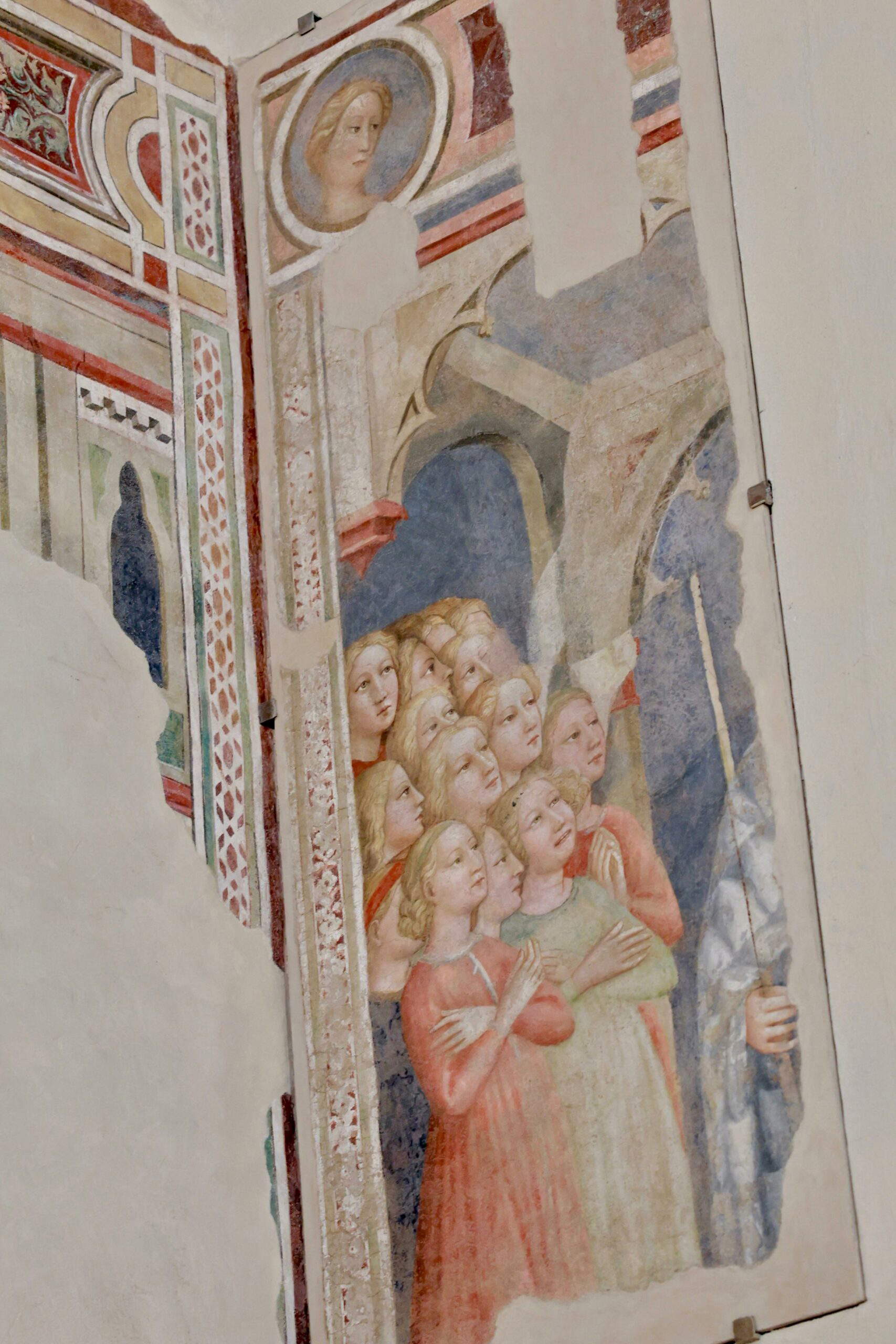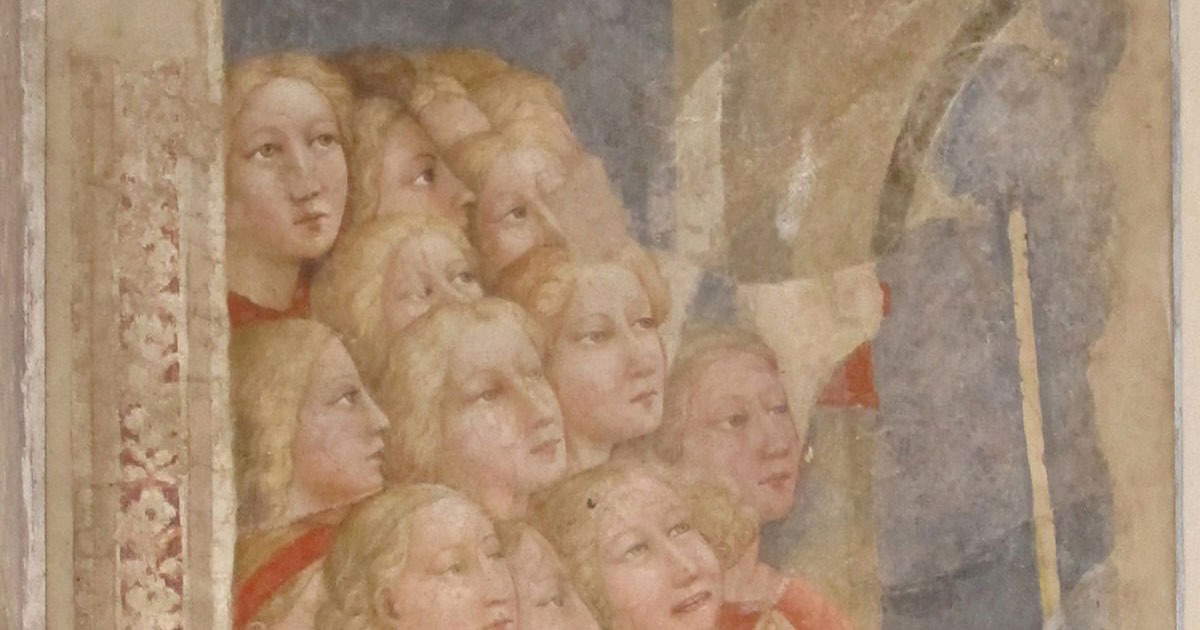On the evening of Friday, June 2025, the restoration of thefresco depicting Saint Ivo among the Pupils by Masolino da Panicale (Panicale, 1383 - Florence, 1440), one of the fundamental figures of the early Italian Renaissance, was presented to the public. Placed in the church of Santo Stefano degli Agostiniani on Via dei Neri in Empoli, the fresco is one of the church’s most significant fragments, and the restoration work has returned this work to its original context, reaffirming the city’s cultural centrality in the artistic panorama of the 15th century. The restoration, supported by the Fondazione CR Firenze and by patrons Stefano and Sabrina Cappelli, of Colorificio Cappelli, and conducted by Lidia Cinelli, is part of a larger project to enhance Empoli’s heritage, symbolically concluded with this intervention, the most delicate and symbolic of the series.
Painted in 1424 by Masolino as a good fresco on the wall of the chapel of the Compagnia della Croce, the fresco was rediscovered in 1943, when numerous 15th-century paintings emerged under the plasterwork during a meticulous campaign of essays conducted by art historian Ugo Procacci. The Saint Ivo among the Pupils was later torn out in 1958, restored and loaned to several international exhibitions. The work is one of the most emblematic images of Masolino’s early production, capable of synthesizing the delicacy of the Gothic line with the new Renaissance spatiality.
The restoration presented on June 20 is the culmination of a journey that began with the exhibition Empoli 1424. Masolino and the Dawn of the Renaissance (our review here), held in the first half of 2024. The exhibition, promoted by the Municipality of Empoli and the Fondazione CR Firenze, represented the largest monographic exhibition ever dedicated to Masolino, with works from prestigious Italian and international institutions. This exhibition had the merit of restoring Masolino to his rightful role in the history of the early Renaissance, no longer just as a comprimario of Masaccio, but as an autonomous and fundamental figure in the definition of a new figurative sensibility.

The restoration of the St. Ivo has made it possible to ideally recompose the cycle of the Stories of the True Cross originally painted by Masolino in the chapel of the Compagnia della Croce, strengthening the link between the exhibition and its territory.The St. Ivo among the Pupils is a work that is still striking for its narrative capacity and expressive delicacy. Gothic stylization coexists with the first hints of a Renaissance perspective, in a balance that marks the transition between two eras. The intervention was directed by Laura Torricini, Elena Alfani and Alberto Felici of the Soprintendenza Archeologia, Belle Arti e Paesaggio for the metropolitan city of Florence and the provinces of Pistoia and Prato. Restorer Lidia Cinelli worked using two different restoration methodologies: “In the case of the fresco of Masolino’s hand, which was uncorked and brought back on a wooden support, I performed the cleaning with Japanese paper and very little water,” she says. “While for the fragment with faux architecture and for the remaining parts of the flounces at the bottom I was able to use cellulose compresses. I performed careful interlayer consolidation in the frill fragments that were completely lifted and detached from the support. Finally on all the paintings I performed plastering and pictorial restoration.”
Alessio Mantellassi, mayor of Empoli, says, “The deep furrow left by an artist like Masolino shows how even today, more than 600 years after that time, our city is incredibly rich in history and culture. Many works are pillars of our heritage, others are being unveiled with important restoration work, and I thank those who have contributed so far for the very successful completion of the work. The public-private collaboration we presented today represents a fundamental pact for the good and future of our city. Indeed, we look to tomorrow to rediscover so many details of history ’at the dawn of the Renaissance’.”

“The restoration of the so-called Saint Ivo among the Pupils,” echoed Culture Councillor Matteo Bensi, “concludes the restoration work on the right transept of Santo Stefano degli Agostiniani. The restorations carried out over the years have not only contributed to restoring the idea of what the church must have looked like in the mid-15th century, but have enabled studies that allow us to read in a different and certainly exciting way the role played by Masolino in Empoli in 1424. The restoration presented this afternoon, which would not have been possible without the important support of the Fondazione CR Firenze and Stefano Cappelli, has brought to light important new information that allows us to partially rewrite that page of city history.”
“This intervention is the result of a virtuous collaboration between the public, private and restoration worlds, which has made it possible not only to enhance an extraordinary artistic heritage, but also to rediscover the meanings and stories within the work itself,” says Gabriele Gori, Director General of Fondazione CR Firenze. "Empoli confirms its centrality in the panorama of the early Renaissance, which we recently had the opportunity to enhance and appreciate in the exhibition dedicated to Masolino that we promoted together with the Municipality of Empoli. The return to the community of a masterpiece like the Saint Ivo among the Pupils perfectly represents the sense of our commitment: to support beauty as a collective value."
“This work by Masolino kept in the church of Santo Stefano degli Agostiniani, thanks to the restoration reveals new aspects,” explains Superintendent Antonella Ranaldi. "Because of its pleasantness and quality, it has been exhibited in exhibitions all over the world in the last century and therefore all the world has known as Saint Ivo with the Pupils has revealed to us, thanks to the work of restorer Lidia Cinelli and Florentine Soprintendenza officials Alfani Felici and Torricini, two things: a new identity with a new iconographic proposal as a representation of St. Ursula and the virgins, and the presence of a sinopia that has never been fully investigated and is waiting to be restored to clear legibility in order to open new perspectives on Empolese artistic life in the first quarter of the 15th century."
Stefano Cappelli and Cristiano Colorini of Colorificio Cappelli say, “We chose to support this project as donors with an awareness that belongs to us: that of materials. Because behind every great work there is also a raw material - then invisible, but essential - that gives shape to the artist’s thought. In our daily work we happen to think that, over the centuries, behind every masterpiece there has always been a merchant, a craftsman, a chemist, a pigment expert, who did not sign the work, but helped make it possible. The fresco attributed to Masolino reminds us precisely of this balance between art, technique and materials. Supporting its restoration was a way for us to honor those who, with humility and expertise, have always worked in the service of artists and beauty, helping it endure. Thanks to all those who made it possible to return this masterpiece to the city.”
 |
| Masolino in Empoli, restored St. Ivo among the pupils in the church of Santo Stefano |
Warning: the translation into English of the original Italian article was created using automatic tools. We undertake to review all articles, but we do not guarantee the total absence of inaccuracies in the translation due to the program. You can find the original by clicking on the ITA button. If you find any mistake,please contact us.